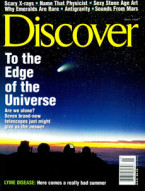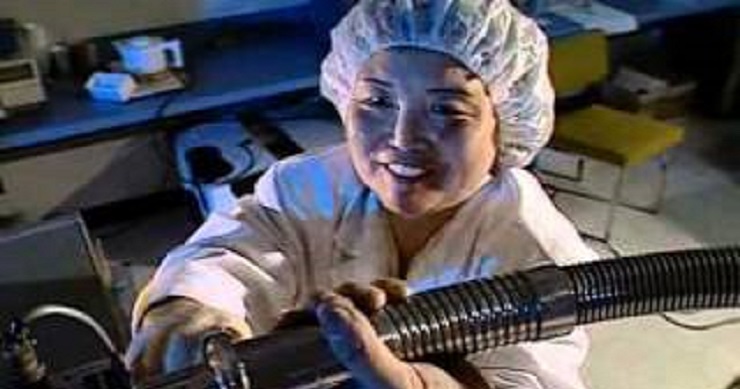 By Corey S. Powell
By Corey S. Powell
Discover, May 1999
New schemes to float free aren’t just science fiction
In her laboratory at the University of Alabama, Ning Li tinkers time and again with a device she believes will transform the world. Tanks of liquid nitrogen and a clumsy array of plumbing surround a chamber in which the temperature has been reduced to 390 degrees below zero. Inside, a disk of an exotic ceramic material that’s about the size of a phonograph record spins rapidly. Levitated by powerful magnets, the disk floats in midair. The contraption may not look like much, but Li insists that the data she is gathering could rid mankind of the shackles that bind us to the planet. “It could change everything,” she says. “Current industry will vanish from the face of the Earth!” A practical antigravity device could allow rockets without propellant or power plants that run without fuel. Li hopes to pave the way by designing an antigravity car–and thinks she can do it in a decade.
Ever since an apple conked Sir Isaac Newton on the head, sober thinkers have tended to sneer at anyone who proposed to defeat gravity. Li herself jokes, “I am not a normal scientist.” Nor is she a crackpot. NASA funds some of her research on the gravity-altering properties of superconducting materials–a phenomenon first reported nearly a decade ago by a Finnish researcher–and three years ago the agency set up an antigravity program of its own at the Marshall Space Flight Center in Huntsville, Alabama. Research on gravity modification (the preferred term in scientific circles) has been gaining credibility, and physicists now speak increasingly of how little we know about what gravity can and cannot do. “The number of anomalies is growing,” says Michael Martin Nieto of Los Alamos National Laboratory.
Japanese researchers were the first to claim some success–however slight–at breaking gravity’s hold in the laboratory. A decade ago, Hideo Hayasaka and Sakae Takeuchi of Tohoku University noticed intriguing signs of lift off while studying the behavior of high-speed gyroscopes with metal flywheels spinning several thousand times per minute. When the gyros rotated clockwise, their weight seemed to drop by about one part in 100,000. Hayasaka and Takeuchi suspected an antigravity effect at work. Most of their peers soon chalked it up to experimental error, however.
Eugene Podkletnov, then a grad student at Tampere University in Finland, inadvertently became a poster child for the antigravity movement in the early 1990s while studying superconducting materials that lose all resistance to electricity when chilled with liquid nitrogen. Podkletnov was hoping to learn more about the behavior of these superconductors when he placed ceramic disks a few inches wide in a cold chamber, passed a magnetic field through them, and then spun them rapidly. What he observed completely took him aback. Objects placed above the disks seemed to lose as much as 2 percent of their weight.
Seeing a little antigravity is like being a little pregnant: either something is there or it isn’t. If the effect is real, people could presumably figure out how to magnify it and exploit it. So tales of Podkletnov’s discovery were soon circulating around the globe. But mainstream scientists remained skeptical. The laboratory conditions needed to create a spinning superconducting disk give rise to many misleading effects that could change the apparent weight of a test mass.
Nevertheless, Ning Li, who had published theoretical papers on antigravity in the late 1980s and early 1990s, promptly rose to the challenge. In collaboration with a NASA team, she constructed superconducting flywheels as much as a foot in diameter–a messy and technically demanding project–and tried to reproduce the results of Podkletnov’s experiments.
Li and the NASA group have since undergone an amicable split. NASA is focusing on validating the basic experiments, while Li is concentrating more on applications. She has stopped publishing papers and no longer speaks of her techniques or experimental results, saying she fears any delays will give foreign researchers the lead.
NASA’s separate and much more public Delta G Experiment (Delta G is a term used to indicate a change in the pull of gravity) is led by project scientist David Noever of the Marshall Space Flight Center. His goal is to eliminate every possible source of error and quantify the exact nature of the gravity modification phenomenon–if it exists. Podkletnov conferred with the NASA researchers last year to share his expertise. “We’re convinced it’s worth exploring,” says Noever, who says Podkletnov turns out to be “a very genuine scientist.” Rumors flashed across the Internet that NASA has already constructed a top-secret antigravity lab, but the truth turns out to be less spectacular. “We haven’t reached the point where there’s stuff floating around the room,” says Noever with a laugh. “This is very much a work in progress.”
More than one way to beat gravity
Meanwhile, physicists are beginning to explore the chances that there may be more than one way to beat gravity. Nieto wonders whether antimatter, which has the opposite properties of ordinary matter, might not fall down when dropped. Anti-matter and matter destroy each other when they meet, so nobody would want to drive an antimatter car. Still, any sign of antigravity would have great theoretical interest. To investigate, Nieto is participating in a project called ATHENA.* Sometime early in the next century, physicists will use two powerful particle accelerators to create antiprotons and antielectrons, trap them, and bring them together to form antihydrogen atoms. The researchers will then cool the atoms of antihydrogen and watch to see whether they plummet under the force of gravity.
If the answer isn’t in the atoms, perhaps it lies in the depths of space. James Woodward of California State University at Fullerton has been studying the connection between gravity and inertia, the tendency of objects to resist changes in acceleration. (Imagine trying to push a car with the transmission in neutral. Although the car rolls freely, it takes a lot of effort to get it going.) According to Einstein, inertia is related to the gravitational field of the whole universe. Giving an object a sudden kick should cause minuscule, temporary fluctuations in its mass. Between his other studies, Woodward says, he “fiddles around” with twisting pendulums and electrical capacitors, searching for these momentary variations. He has found provocative indications that he can modify the mass of an object, although he is daunted by the many possible sources of error. “The likelihood for success is not large, but the practical payoffs are potentially staggering,” he says. For instance, he thinks it should be possible to “steal” a little extra push from the distant parts of the universe, and do it repeatedly. This process might form the basis of a fantastic new kind of propulsion. NASA is listening here too. Two years ago the agency established a Breakthrough Propulsion program to investigate mass modification and other speculative schemes for space travel.
The best-documented antigravity effect comes not from laboratory experiments but from studies of exploding stars, or supernovas, in distant galaxies. Two teams of astronomers are studying the brilliant flashes of light from supernovas to see how quickly the cumulative pull of the matter in the universe is slowing the Big Bang. Early results have produced an unexpected result: rather than slowing down, the universe appears to be speeding up. Many scientists take this finding as evidence of a “cosmological constant”, a latent energy hidden within the fabric of space that counteracts the tug of gravity. In their wilder speculations, scientists like Hal Puthoff of the Institute for Advanced Studies in Austin, Texas, speculate that the energy that gives rise to the cosmological constant is also responsible for the phenomenon of inertia, linking the universal antigravity back to potential gravity-fighting techniques here at home. Although the theory is only still only half-formed, “it’s a very fruitful area of study,” Noever says.
If the experiments hold up, explanations can come later. After all, Thomas Edison didn’t need a quantum model of radiation to make a lightbulb.
COPYRIGHT 1999 Discover
COPYRIGHT 2000 Gale Group
Bibliography for “Zero Gravity – antigravity devices”
Corey S. Powell “Zero Gravity – antigravity devices”. Discover. May 1999.
Related Content:
- All Things Dr. Ning Li (Taming Gravity Tag)
References:
- Discover Magazine
- * Scientists-Make-Antimatter (Original 2002 Video)


I enjoyed the article, yet in my opinion:
The best proof of anti-gravity comes from LAB Experiments: Alzofon experiment 1994, using microwaves DNO (see https://vixra.org/author/lucian_m_ionescu), and from Ning Li, Podlekov experiments using superconductivity.
The Cosmological data is too much prone to interpretations according to one theory or another (limitations of GR, “dark stuff” concepts, cosmological constant etc.)
Thank you vey much for your comment. It is a great reference source for research on the subject of taming gravity! Again, thanks so much! I’ll be using it for more post here on Taming Gravity.